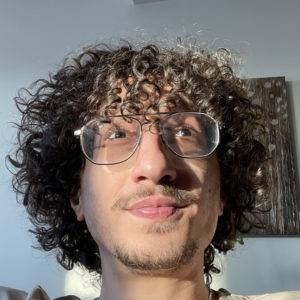Adidas launched their NFT project recently to much acclaim, with one of the most critical partners being Gmoney.
Gmoney has been an icon in the NFT space, widely recognized and respected for his insight and ideas. I sat down with Gmoney for a quick interview to capture some more of those ideas in longer form, documented in this interview transcription:
Rami: Thank you for taking the time. Very excited to get your perspective on some things here today. So, most interviews start with an introduction. Would you like to offer one, whether it be personal or pseudonymous?
Gmoney: So I’m Gmoney. I’m a collector, investor, and general NFT advocate for the space.
Rami: That sets the stage. So many NFTs get their value from exclusivity, right? A limited amount of pieces in a collection or a small number of parcels in a metaverse. And with this system, the earliest adopters benefit the most, with less opportunity for those who hear about projects later. So in your opinion, how much of NFT’s and their value is derived from this sense of exclusivity?
Gmoney: Yeah, well, I think you’re looking at it through the wrong lens, right? It’s more of how do I ‘engage with’ and ‘reward’ those fans that are the early adopters, right? If I found out about a band, and all these web tools existed 20 years ago, and I found out about my favourite band, I don’t know, Maroon Five or something. And I saw them play live at a concert and became a fan of their music, of course. I did buy their merchandise, and I can buy all their songs and go into their concerts while they were building up their fan base before they truly went global, but there’s no way I’d be able to experience some of that upside from being an early supporter.
So I think the current state of NFTs at the moment is like, if I am an early member of that community, then by helping build that community, I get to experience some of that upside. Now, I think NFT’s are in an interesting spot where because that success happens, and because at this moment, the limited editions that there are of NFT’s then start to skyrocket, and you start getting into something where the prices start going way higher than then maybe your entry-level participant that joins later can get at. But I do think we’re starting to see projects and communities coming up with already, almost like different tiers.
I think what you see over time is the community will still be made accessible; just as you come in later, maybe there’s different “tiers,” for lack of a better term. There’s different ways to get involved, different ways, and different price points to get involved. And I do think that because we’re still in the nascent stages of the whole space, we’re just learning and going. So to me, making it sound like it’s an air of this “exclusivity,” I firmly believe that it’s not what it is. It’s that if you’re an early adopter, then part of the whole Web3 narrative is you get to experience some of that upside for helping them, for believing, and being there really early. So to me, it’s more of a way to incentivize and to give a ‘thank you’ to people that believe in you from the beginning.
Rami: Yeah, I can definitely see how that would reward earlier adopters for advancing the community and building it up to what it could be in the future. And it kind of answers the follow-up question that I had there regarding whether NFT’s can offer as much value by being more inclusive, perhaps in the future, than exclusive.
Gmoney: Yeah, I think for some reason 10,000 has been the secret number, the magic sauce. But obviously, over time, as more and more people get involved in the space, that number won’t hold, and that number will only be going higher over time. So you have to sit there and, as a project, as a community, you have to think about, alright, how do we scale this? And how do we get more people involved? Because obviously, nobody just wants a user base of 10,000, right? Like, you really want people to create these large and massive communities for people and like-minded individuals to engage. And I do think that we’re just at the early stages, which is why it seems like it has a lot of exclusivity. But I think in the long run, most communities will not want that exclusivity because they want that scale. After all, they want to be inclusive. That’s kind of the whole ethos of Web3- is how you can include these people that weren’t able to participate in a lot of the upside that they helped create for Web2 and reward them in Web3?
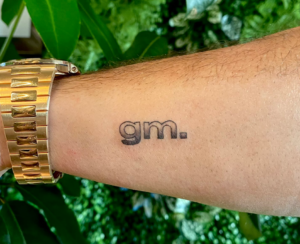
Photo Credit: Gmoney
Rami: Yeah, it’s definitely something facilitated by blockchain technology, NFTS, and as we’re recently seeing, fractionalization of NFTs using ERC-20 tokens. What are your thoughts on the fractionalization of NFT’s and the ability to allow more people to participate in the upside that a particular project may have?
Gmoney: Yeah, I mean, I love it. I think you see it with a lot of the high-value assets in the space already with Punks, some Artblocks stuff, some super high stuff that’s generally no longer made accessible to most people. Like it’s a very small percentage of the population that can allocate the $400,000 that it is to buy a Punk, right? But if you want exposure to CryptoPunks, because you believe in it and you want to have access, the best way to do it is to buy a piece of a fractionalized Punk. Because then you have exposure to the asset and to the Punk market. So I think fractionalization is incredible for democratizing access to these assets that otherwise would have only been available to public markets where you have to wait for valuations to get to a certain amount before they become public. So to me, fractionalizations are key elements to democratize the access to these assets.
Rami: Awesome. You touched on portfolio allocation; you come from the legacy equity trading realm. But regardless, what are your opinions on NFTs and their impact on the advancement of culture? Will the art that we see henceforth be different as a result of the innovation of NFTs?
Gmoney: Yeah, I think it’s a new medium, right? So I think artists, who are some of the most creative people in the world, are given this new way to create things and experiences for people to ingest. And I think it’s super powerful. Because when anybody asks, ‘what can I do with NFTs?’ Like literally, whatever you want. You can link it to a physical; you can link it to an experience; you can link it to just, you know, a JPEG; you can link it to a movie. It’s all these different things. It depends on how you want to interact with your community; you can figure out what you want to do and how you want to do it. I think, depending on how cool the product is, you’re going to get your adoption or not. So to me, I think that NFTs are super important 1) for taking crypto mainstream but 2) kind of giving artists this new tool that they now have in their back pocket to not only create cool and exciting things but to also participate in more of the financial upside that they otherwise wouldn’t do with traditional means.
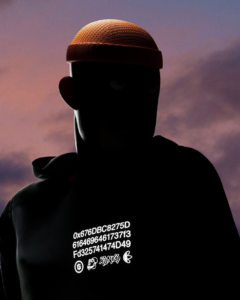
Photo Credit: Gmoney
Rami: Yeah. I’ve heard you mention that you used to play Fortnite and that was part of your realization that NFT’s could become really valuable since the generation that has been interested in spending money on skins can now potentially make money by trading these assets back and forth in the future. But a question there could be if you buy an NFT for a particular game, a skin, an asset that can be used in that game, and that platform itself were to go down. Do you think that NFT and the value of it could continue to survive post-platform-mortem?
Gmoney: I mean, I think it’s a case-by-case basis. There’s not enough information in that question to answer. I think that some things that are historically relevant will still retain value. Would it have the same value? Obviously not because the whole utility aspect of it for that asset would be gone. But, you know, maybe somebody builds something else at some point in the future? I don’t know. I think there’s a lot of different variables for me to give you a yes or no answer on that.
Rami: That’s fair. There is at least that potential for the value to rebound if somebody can take advantage of that asset and utilize it in new ways. So it’s not the end of the world, potentially, if a platform were to go down, so to speak. Another question, you attended the PleasrDAO event in NFTNYC recently, an organization notably focused on charity in NFTs. Do you think NFTs have novel ability to generate positive social impact?
Gmoney: Yeah, I mean, I think that it’s just like with creators; it’s another tool that people will have at their disposal to utilize. And I think you’re starting to see that now with a lot of non-profits trying to figure out, okay, how can we sell, fund, how can we create some more sustainable funding to fund the initiatives that we want? And go from there. And yeah, I think NFTs are going to have a massive positive impact across every industry in the world. And we’re starting with art, and then we’re going to be branching out into other industries over time.
Rami: And you’ve mentioned play-to-earn games as being the next potentially big thing. So from that sense, do you think the realm of legacy gaming could be the ones to benefit most from the adoption of NFT’s? Or do you see any other industry where it might be very well suited that it has not been applied to yet?
Gmoney: I mean, every industry. I think it will be happening over time. I think right now, we’re seeing gaming getting disrupted. I mean, I have my guesses as to what could be coming next, but I do think that it’s one of those things… I don’t know. Maybe somebody from some industry has been working on some sort of solution that might come out next week, and that might be a big aha moment for other people in the industry. So I think every industry will be impacted, and I think it’s just a matter of time. And as more and more people get exposed to [blockchain] technology, more people will be coming up with ideas of how to utilize it.
Rami: Yeah. I agree with that; it’ll be interesting to see where that goes. Yourself and 6529 have notably acknowledged that the term “NFT” is a branding disaster. Not too long ago, you offered up some suggestions, some of which included dArt for digital art, NFHat for Non-Fungible Hat, B-Skin for Blockchain Skin, and C-Mortgage for Chain Mortgage. Do any of those terms still resonate with you? Or were there any others that may have arisen since then that you think could be a good term to adopt instead of “NFT?”
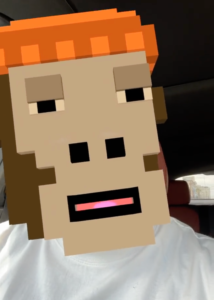
Photo Credit: Gmoney
Gmoney: No, I haven’t seen anything; I haven’t really been following that conversation, but I just know that we’re going to need to have something that’s a more descriptive term. Just because like, I’ve said in that post, calling something a “thing,” which is basically what you’re doing by calling it an “NFT,” is like me pointing at your hat and being like, “that’s a thing,” and then pointing at your shoes and saying, “that’s the same thing.” So we’re going to have to come up with some sort of better standards for describing things. I don’t know what that will be. But I don’t think “NFT” as a term to describe the entire segment will stick over time.
Rami: Fair enough. And given the different ways that NFTs can be used from the sale of digital art, to governance, to fractionalization, to the representation of virtual real estate. Do you think each one of those would necessitate its own term? Or can an umbrella term be found to be inclusive of them all?
Gmoney: I just think we’re going to need more descriptive things for the reasons I just said. You know, you can’t call everything something. So I don’t know what the standard will be, I don’t. I’m not trying to deal with some standard. I just know that over time, we’re going to need to have things that are more descriptive.
Rami: Fair enough. A couple more questions I have for you. Your website, G.money, just says, “stay tuned.” Anything you would like to allude to in regards to what’s coming out there?
Gmoney: Just said, something’s coming soon.
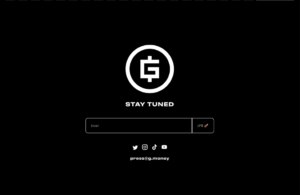
Photo Credit: g.money
Rami: Alright. I’m sure a lot of people are interested, worth a shot. Finally, I have one more question for you. It’s not Sunday, but what are you grateful for?
Gmoney: Today, I’m grateful. I’m looking at the Manhattan skyline as I talk to you right now. So I’m grateful that I’m able to have this experience in this moment of time, experiencing the growth of this industry that I think is going to be impacting humanity in a very positive light, and being able to help put it in the direction that I think is best for our children and grandchildren.
Rami: I think we share that optimism for the future.
Gmoney: Awesome.
Rami: Yeah. Those are the questions that I had for you. I appreciate you taking the time.
Gmoney: I appreciate you.
Rami: I wish you all the very best with everything that you have coming up. And yeah, just thanks again for my side.
Gmoney: Okay, awesome. Thank you. Thanks for your time. I appreciate it.
Gmoney’s participation in projects and in the NFT space overall will continue to drive new ideas in an atmosphere that evolves daily. His opinions are practical, analytical, and enjoyable and can be followed on Gmoney’s Twitter with an eye on what’s to come on the g.money website soon.

